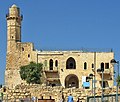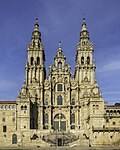Figures mentioned in the Torah
| Biblical figure | Place name and location | Image | Notes |
|---|---|---|---|
| Adam | Judaism and Islam: Cave of the Patriarchs, Hebron, West Bank Shia Islam: Imam Ali Mosque, Najaf, Iraq Christianity: Chapel of Adam, Church of the Holy Sepulchre |   | |
| Eve | Judaism and Christianity: Cave of the Patriarchs, Hebron, West Bank, Islam: Tomb of Eve, Jeddah, Saudi Arabia |   | |
| Abel | Nabi Habeel Mosque, Zabadani Valley, Syria |  | |
| Seth | In Judaism: Tiberias, Israel In Islam: Bashshit, Palestine (top), |   | |
| Lamech | Islam: Tomb of Lamech, Mihtarlam, Afghanistan | Seen here | |
| Noah | There are several Islamic sites that are claimed to be the Tomb of Noah:
| ||
| Abraham, Sarah, Isaac, Rebecca, Jacob, Esau, and Leah | Cave of the Patriarchs, Hebron, West Bank |  | According to Jewish and Christian tradition, only Esau's head is buried in the Cave of the Patriarchs. According to legends, Ishmael was buried here as well.[ citation needed ] |
| Ishmael and Hagar | Islam: Hajr Ismail, Mecca, Saudi Arabia [2] |  | |
| Lot | Islam: Bani Na'im, near Hebron, West Bank |  | |
| Rachel | Rachel's Tomb, outside Bethlehem, West Bank |  | |
| Zilpah, Bilhah Jochebed, Zipporah, and Elisheva | Tomb of the Matriarchs, Tiberias, Israel |  | |
| Reuben | Nabi Rubin, Palmachim, Israel |  | During the Ottoman period, Arabs would gather each year at the Mamluk-era structure. Nowadays, infrequent Jewish visitors come to pray at the site. |
| Judah | Yehud, Israel [3] |  | |
| Simeon | Kibbutz Eyal, Israel. |  | |
| Asher and Naphtali | Tel Kedesh near Malkia, Israel | Seen here. | |
| Gad | Prophet Jadur Shrine, Ain Al-Jadur, west of Salt, Jordan |  | The current mosque, built around the tomb, is a modern structure, which dates back to the year 1958. The site has fallen into disrepair and had even been looted as well. |
| Dan | Beit Shemesh, Israel [4] |  | |
| Qedar | Mausoleum of Prophet Qeydar, Zanjan, Iran |  | Qedar, the son of Ishmael, is believed by the Shi'ites to have been buried in Zanjan. The current mausoleum is a 14th-century reconstruction that has been renovated a few times. |
| Zebulun | Tomb of Zebulun, Sidon, Lebanon | Seen here | Currently a Shi'ite shrine which is still locked to the public. In the past, towards the end of Iyyar, Jews from the most distant parts of Palestine and the Jews who lived in Lebanon would make a pilgrimage to this tomb. [5] |
| Joseph, Ephraim, and Manasseh | Judaism and Christianity: Joseph's Tomb, Nablus (Shechem), West Bank; Islam: Cave of the Patriarchs, Hebron, West Bank, |  | Some others consider Joseph to have been buried next to the Cave of the Patriarchs, where a mediaeval structure known as the kalah (castle) is now located. Some archaeologists believe that the site in Nablus is only the tomb of a Sufi Muslim Shaykh named Yusuf, and not Joseph himself. |
| Benjamin | Kfar Saba, Israel |   | Two structures 30 m away from each other (both pictured) are each claimed by Jews, Muslims and Christians as the authentic tomb. This site is questionable, however, because it is not located in the territory of the Tribe of Benjamin.[ citation needed ] |
| Serah | Pir-i Bakran, near Esfahan, Iran [6] |  | |
| Moses | Mount Nebo (Jordan) Islam: Nabi Musa, West Bank, |  | According to the Bible, the exact place of Moses' grave remains unknown, in order to impede idolatry. |
| Aaron | Tomb of Aaron: Mount Harun near Petra, Jordan. |  | At 1350 meters above sea-level, it is the highest peak in the area; it is believed to be the place where Aaron died and was buried. A 14th-century mosque stands here with its white dome visible from most areas in and around Petra. |
| Eleazar and Ithamar | Awarta, West Bank [7] |  | Due to the uncertain security situation, the Israel Defense Forces limits visits by Jews to one annual night close to the 5th of Shevat on the Hebrew calendar (around January–February).[ citation needed ] |
| Jethro | Nabi Shu'ayb, Hittin |  | Each year on April 25, the Druze gather at the site to discuss community affairs. [8] |
| Aholiab | Sujod, Southern Lebanon [9] |  | Located at 33.4428°N 35.5381°E. Destroyed after the Israeli occupation of Southern Lebanon. |























































